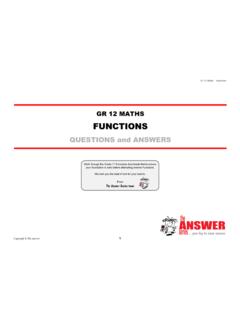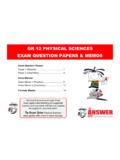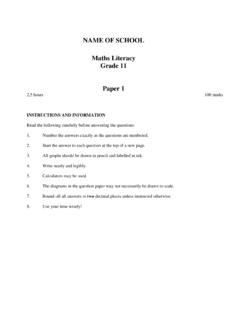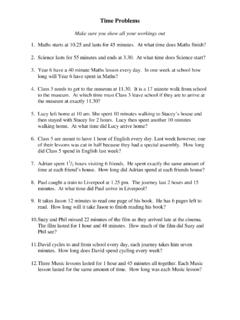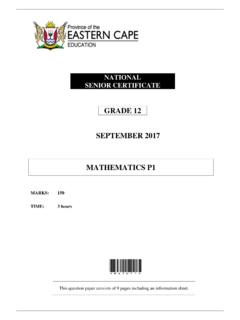Transcription of Functions and Graphs GR 11 MATHS - The Answer
1 Gr 11 maths Functions and Graphs Copyright The Answer 1 Graphs in general: Background Required 3 Basic facts about Graphs in general : Axis intercepts Every point on the y-axis has x = 0. Every point on the x-axis has y = 0. : The equation The equation of a graph is true for all points on the graph. The equation of the y-axis is x = 0; the equation of the x-axis is y = 0. : Types of graph Different types/patterns are indicated by various equations. 4 types of Graphs Straight Lines Parabolas Hyperbolas Exponential Graphs The Straight Line It is critical to successfully identify whether an equation is going to giveyou a straight line, a parabola, a hyperbola or an exponential graph. Dual intercept method Find the y-intercept by putting x = 0 Find the x-intercept by putting y = 0 Gradient-intercept method Convert the equation into standard form y = mx + c and read off the gradient (m) and y-intercept (c) How to draw a straight line GR 11 maths Functions & Graphs All forms of straight line equations: y = mx + c ; y = mx ; y = c ; x = k To find the equation of a straight line you will need to determine m and c in the equation y = mx + c or a and q in the equation y = ax + q (unless the line is a 'grid line' y = c or x = k !)
2 How to determine the equation of a straight line Where does y - y1 = m(x - x1) come from? If (x1; y1) is a specific (given) point and (x; y) represents any other point on the line, then 11y - yx - x = m, the gradient of the line % (x - x1): y - y1 = m(x - x1) Apply this equation: Given point (2; -3) and m = 4: y - (-3) = 4(x - 2) y + 3 = 4x - 8 y = 4x - 11 A very quick and easy method!(x; y)(x1; y1) xy(0; 2)(3; 0)OThe x-coordinateis zeroThe y-coordinateis zeroGr 11 maths Functions and Graphs Copyright The Answer 2 The Parabola The Hyperbola How to draw a sketch of a parabolathe axis of symmetry & the min/max value of yPut x = 0 to find the y-intercept Put y = 0 to find the x-intercept(s), if anya > 0: or a < 0: Decide on the shape Then, in any order, determine: the turning point the axis intercepts The form of the equation will determine the order: or first.
3 How to determine the equation of a parabola Case 1: Given the turning point, (p; q), use y = a(x -- p)2 + q Substitute (p; q) in the turning point form of the equation; Then substitute any other point to find a Case 2: Given the roots, A and B, use y = a(x -- A)(x -- B) Substitute A and B in the root form of the equation; Then substitute any other point to find a. How to draw a sketch of a hyperbola Draw the asymptotes: x = p & y = q .. note the 'new grid' Decide on the quadrants on the grid. Calculate the axis intercepts. Determine the axes of symmetry. Put x = 0 to find the y-intercept Put y = 0 to find the x-intercept y = x y = (x - p) + q and y = -x y =-(x-p)+ q a > 0: or a < 0: How to determine the equation of a hyperbola : Determine p and q Write down the equations of the asymptotes: x = p and y = q ; then, substitute the values of p and q into the equation: y = - xap + q : Determine a Substitute any point, (x; y), on the graph to determine the value of a.
4 The 3 General forms are: Turning point form y = a(x - p)2 + q (p; q)Root form y = a(x - A)(x - B) roots A & BStandard form y = ax2 + bx + c y-interceptEquation in standard form: y = apx - + q Gr 11 maths Functions and Graphs Copyright The Answer 3 NOTES Exponential Graph Equation in standard form: y = x - pab + q How to determine the equation of an exponential graph, given a sketch. There are 4 parameters to be considered: Write down what you can, q = .. , if the asymptote has been shown. Find the remaining parameters by substituting points. Note: The 'zero value' of x, when x = p, eliminates b because b0 = 1, so always substitute this point first. How to sketch an exponential graph, given the equation Determine the equation of the asymptote: y = q Determine the axis intercepts, y-int (x = 0) & x-int (y = 0) Interpret the parameters: a shifts up and down p shifts left and right b determines direction of graph This package of summaries contains extracts from our Gr 11 maths 3 in 1 study guide.
5 We trust that this will help you to grow in confidence as you prepare for your exams. The Answer Series study guides have been the key to exam success for many learners. Visit our website to find appropriate resources for your success! 11 maths Functions : Questions Copyright The Answer 4 Hint: If a vertical line cuts a graph more than once, it is not a function. If all vertical lines will cut a graph once (only), then the graph is a function. CHARACTERISTICS OF Graphs & Functions Examinable in both Grade 11 and Grade 12. Identifying different types of Graphs is very important! 1. On a separate set of axes, for each, draw Graphs of: y = 4 - x2 y = x1 - 4 y = 4 - x y = -x4 y = x4 y = 4x (6 % 3 = 18) Six Graphs named (a) (f) are sketched below. They are followed by 10 equations. Match the Graphs with the equations.
6 Write down (a) (f) and alongside these, the number selected from (1) (10) that is the equation of the graph. (a) (b) (c) (d) (e) (f) List of possible equations (1) xy = 2 (2) xy = -2 (3) y = -2 (4) x = -2 (5) y = x2 (6) x = y2 (7) y = 2x (8) y = 2x (9) y = 2x + 1 (10) y = 2x - 1 (10) Write down (a) (f) and say whether the graph represents a one-to-one, a many-to-one or a one-to-many relationship between the values of x (the domain) and the values of y (the range). (6) Which of the Graphs (a) (f) are not Functions ? Why not? (4) Write down the domain and range of Graphs (a) (f). (12) Write down the equations of the asymptotes in (c) and (d). (3) Draw sketches to show the reflections of point P(5; 2) (a) in the y-axis (b) in the x-axis (c) in the line y = x (6) Describe the change in the coordinates in each case.
7 (3) Note the reflections of the Graphs in the line y = x in the following cases: (a) (b) (c) Write down the coordinates of the points A to F which are reflections of the given points in the line y = x. (6) Determine the equations of the reflected Graphs in (a), (b) and (c) by inspection. (3) Draw the reflections of the following Graphs in the line y = x. (6) (a) y = x2 (b) y = x2 ; x 0 (c) y = x2 ; x 0 Are the reflections drawn in Functions ? (3) Determine the equations of the reflections drawn in (6) Given any function, y = f(x), line, hyperbola, parabola or exponential, describe the transformation required for the following images of f to be obtained: A y = f(x) + 1 B y = f(x) - 2 C y = f(x + 1) D y = f(x - 2) E y = f(-x) F y = -f(x) (6) Match the black graph in each of these sketches to the equations A, B, C.
8 In (The grey graph is the original graph f in each case.) (6) (i) (ii) (iii) (iv) (v) (vi) Four Graphs (a) (d) are sketched below. Are any of these Graphs Functions ? Give reasons. (2) (a) (b) (c) (d) Match Graphs (a) (d) with the equations (1) (6) below. Write down (a) (d) and alongside these the number selected from (1) to (6) that is the equation of the graph. (1) y = x2 (2) y = x2 ; x 0 (3) y = -x2 (4) y = -x2 ; x 0 (5) x = -y2 (6) y =x ; x 0 (4) Draw the graph defined by y = x. (2)-y xO (2; yO x x O yOy xy xO (0; 1)xyy = x + 1y = xAB(-1; 0)Oxy (0; 1)y = 2xEOF(2; 8)y = xyx Of2y x O fyxOf yxOyxO2yxOf2 Oyx(0; 2)y(-1; 0)y = 2x + 2 CDy = xOx(0; 0)x y(1; 1)(3; 9)(0; 0)xy(-2; 4)(-1; 1)yxOy xO yxOf12fyxOf-1(0; 0)xy(-2; 4)(1; 1)(3; 9) Functions QUESTIONS Gr 11 maths Functions : Questions Copyright The Answer 5 7.)
9 Which of the following Graphs (if any) are not Functions ? Why? (2) A B C D E F If point P(1; 8) lies on the graph of the function f(x) = 2x + a, determine the value of a. (2) If h is the graph f moved 2 units to the right and 5 units down, write down the equation of the graph in this new position, the equation of h. (2) Write down the equation of the asymptote of the shifted graph, h, in Question (1) Do the points (-1; 2) and (-1; -2) lie on a function? Why (not)? (2) For which value(s) of x would the points P(2x; x + 6) and Q(x + 5; x) NOT lie on a function? (2) Determine the domain of the function y = (x - 4)-1. (2) Write down the equations of the asymptotes of this function. (4) If the graph in is moved 2 units left and 1 unit up, write down: (a) the equation of the graph in this new position, and (2) (b) the equations of the asymptotes.
10 (2) 11. Given: f(x) = x2 - 4x - 5, calculate the x-intercepts of f. y-intercept of f. (3)(1) coordinates of the turning point. (5) Draw a neat sketch graph of f, showing clearly all intercepts on the axes and the coordinates of the turning point. (5) What is the largest value of c for which x2 - 4x - 5 c for every value of x? (2) Use the graph to solve for x if x2 - 4x - 5 0. (2) Without any further calculations, sketch the graph of g(x) = -x2 + 4x + 5. (2) For which values of x does g(x) decrease as x increases? (1)12. The accompanying sketch, not drawn to scale, shows the Graphs of the Functions defined by: f(x) = -x2 + 2x + 3 and g(x) = mx + c. Find the coordinates of C, the turning point of the curve of f. (4) Determine the length of KC. (1) If A and B are the x-intercepts of the curve of f, find the length of AB.





